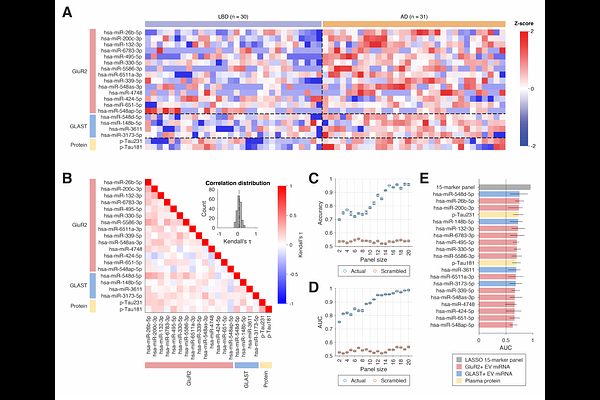Brain-derived extracellular vesicle microRNAs in Lewy body and Alzheimer's disease

Brain-derived extracellular vesicle microRNAs in Lewy body and Alzheimer's disease
Yang, S. J.; Lin, A. A.; Shen, H.; Pappalardo, L. W.; Spychalski, G. B.; Rosario, J.; Forsberg, L. K.; Grant, K. M.; Savica, R.; O'Bryant, S.; Jones, D. T.; Dickson, D. W.; Reichard, R. R.; Nguyen, A. T.; Meaney, D. F.; Boeve, B. F.; Ross, O. A.; McLean, P. J.; Issadore, D.
AbstractINTRODUCTION: Robust plasma-based biomarkers to distinguish Lewy body disease (LBD) and Alzheimer\'s disease (AD) are currently lacking. We applied track-etch magnetic nanopore (TENPO) sorting for enrichment of brain-derived extracellular vesicle (EV) signatures as potential biomarkers to address this gap. METHODS: We analyzed plasma from 137 autopsy-confirmed patients [30 LBD, 31 AD, 30 AD/LBD, 19 AD with amygdala Lewy bodies (AD/ALB), and 27 controls], sequencing miRNAs from TENPO-isolated GluR2-positive (neuron-enriched) and GLAST-positive (astrocyte-enriched) EVs, and measuring plasma proteins (A{beta}40, A{beta}42, tau, p-Tau181, p-Tau231) via SIMOA. RESULTS: We identified 16 GluR2+, 8 GLAST+, and 4 protein biomarkers with differential expression (false discovery rate-corrected P value < .1) between LBD and AD. A multimodal 15-feature panel classified LBD versus AD with 10-fold cross-validated accuracy = 0.95 and area under the curve (AUC) = 0.96. DISCUSSION: Brain-derived EVs offer accurate and accessible miRNA biomarkers for the differential diagnosis of LBD and AD.